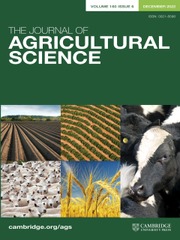Article contents
The interaction of seed rate and pesticide on the tiller density, herbage yield and frit fly population of newly sown grass
Published online by Cambridge University Press: 27 March 2009
Summary
The relationship between seed rate and use of pesticide (chlorpyrifos and aldicarb) on tiller density and herbage yield of a conventionally established autumn re-seed (i.e. grass sown after a previous grass crop) of Italian ryegrass (cv. RvP) was investigated in small plot trials at three sites in Yorkshire, Berkshire and Devon in August 1984. Plots were also sampled for pests and earthworms. Pesticide enhanced yield at all sites at the first harvest in October 1984, particularly at the low seed rates, but this effect did not persist until the spring harvest in 1985. Tiller density and herbage dry-matter yield increased logarithmically with increasing seed rate. Frit fly was the major pest and the proportion of infested tillers increased linearly with seed rate. Low seed rate in combination with appropriate insecticide was more cost effective than untreated higher seed rates in the establishment of autumn re-seeded Italian ryegrass.
Information
- Type
- Research Article
- Information
- Copyright
- Copyright © Cambridge University Press 1986
References
- 3
- Cited by

